Well, who doesn’t like the blue ones, as the eggplants are affectionately called in the south? Growing them there is quite simple - a long, warm summer helps. In the middle lane it is much more difficult if you land them in the open ground. But there is a great way to get the crop, and in this case, use closed ground: growing and caring for the eggplant in the greenhouse is simple, subject to all the rules of agricultural technology, they will give a plentiful harvest there. But this is if the varieties are selected correctly.
Material Content:
Varieties of eggplant for a greenhouse
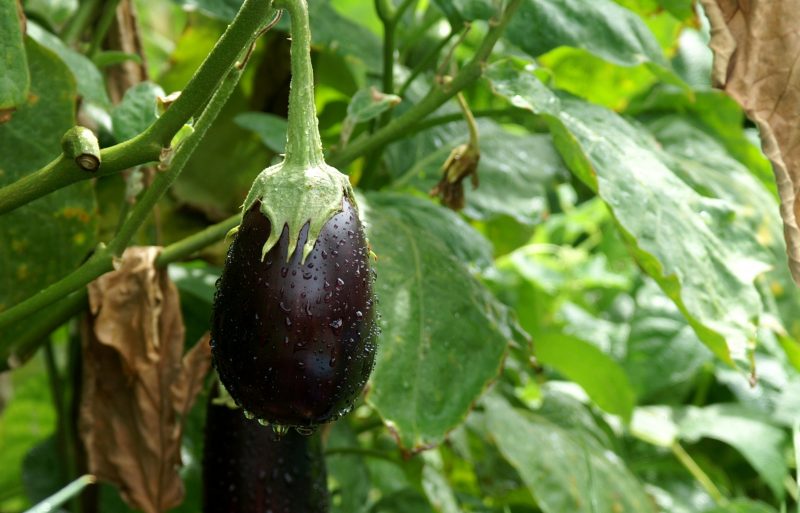
In order to maximize the benefit of using every meter of covered ground, you need to select varieties with high productivity for planting in the greenhouse. For the middle zone and the northern regions, the ripening dates of the vegetable are very important. Late-ripening varieties simply do not have time to give the crop that they are capable of. Preference is given to those eggplants that do not have bitterness and are able to resist diseases. The following varieties and hybrids can be recommended.
Robin the Hood.

It has a super early ripening period - the first fruits can be harvested already 3 months after germination. The bush is up to 1 m high. The fruits are lilac in color, pear-shaped and weigh up to 300 g. m can plant up to 5 plants. Easily adapts to any growing conditions.
Joker.
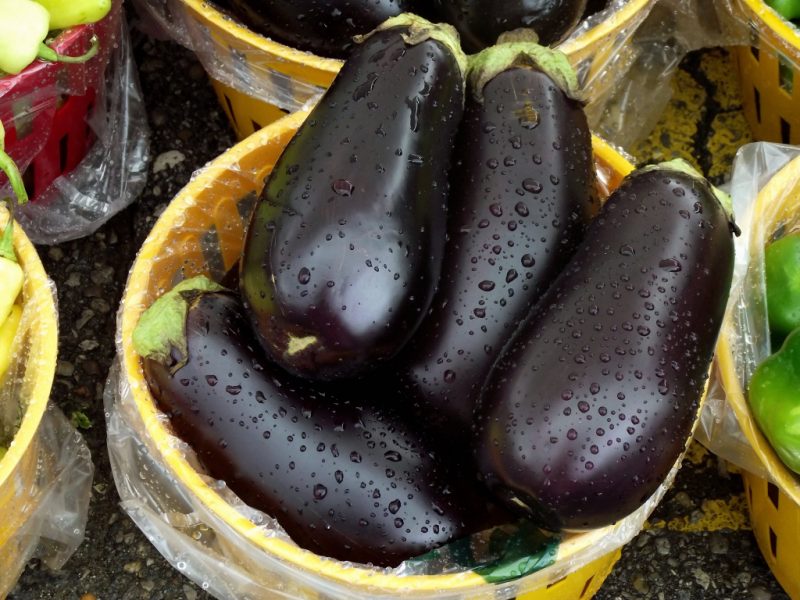
Refers to a new type of eggplant - carpal. Fruits of light weight - from 50 to 130 g, but in the brush there can be up to 7, so the whole crop is very good. The bright lilac color of the fruits also attracts. The plant itself reaches a height of 130 cm. The ripening period is super-early. The first fruits ripen 3 months after full germination.Planting rate - 5 plants per square meter. m
Vakula.
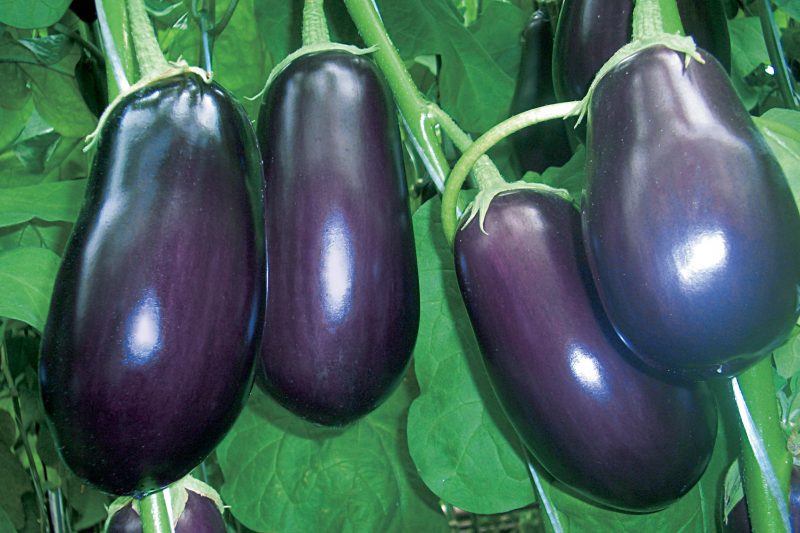
It belongs to the early varieties, as it ripens 3.5 months after germination. A bush of medium height - up to 1.2 m is hung with purple ellipsoidal fruits with considerable weight. Individual specimens are pulled by 1 kg, and the average weight of the vegetable is 450 g. There are no thorns at the stalk. Gives the crop together. Due to the high load of the crop, the plants need to be tied up, and in order to ripen all the set fruits and form. Per sq. m you can plant from 3 to 5 plants.
Don Quixote.
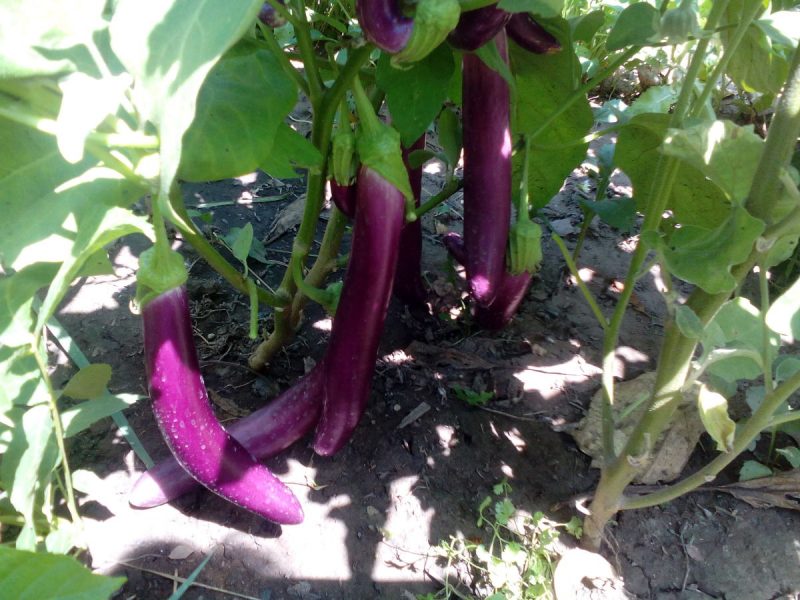
By maturity - it is medium early, ripens after 4 months from seedlings. The bush grows to 1.8 m, with sparse foliage. The fruits are saber-shaped, dark purple in color, weigh from 300 to 400 g, have few thorns. The variety is almost not affected by a spider mite. Per sq. m you can plant from 3 to 5 plants.
Romantic.
Mid-early variety. The first fruits reach technical ripeness 4 months after germination. The bush is spreading, reaches a height of up to 1.7 m. It is formed into 2 stems with a mandatory garter. The elongated oval fruits have a beautiful pink with a lilac hue. Per sq. m can plant up to 3 plants.
Pink flamingo.
Belongs to mid-early grades. The first fruits are ready for harvest 4 months after emergence. The bush, depending on the fertility of the soil, can grow from 80 to 150 cm. With good care, up to 6 pinkish-purple slightly curved cylindrical fruits weighing up to 450 g can form in each internode.
Sancho Panza.

The first fruits can be tasted about 130 days after emergence. The bush with sparse foliage has a height of up to 1.5 m. Fruits in the form of a ball of dark purple color weighing 700 g. Planting density - up to 4 plants per square meter. m
The fruits of all of the above varieties for the greenhouse do not have bitterness and are distinguished by excellent taste. Growing eggplant is not possible without seedlings. Not only the crop, but also plant health depends on its quality.
Eggplant belongs to the cultures of short daylight hours - up to 12 hours, if it lasts longer, they simply do not set fruit.
Choose for planting zoned varieties that can bear fruit regardless of the length of the daylight hours.
Growing seedlings at home
Growing eggplant for seedlings begins with the preparation of seed. Calibrated seeds are etched in a potassium permanganate solution of 1% concentration for 20 minutes or in a 2% hydrogen peroxide solution heated to 40 degrees for 5 minutes. This procedure cannot be neglected - eggplants are prone to all diseases of plants from the nightshade family and may contain their pathogens on the surface of the seeds. After dressing, the seeds are washed with running water.
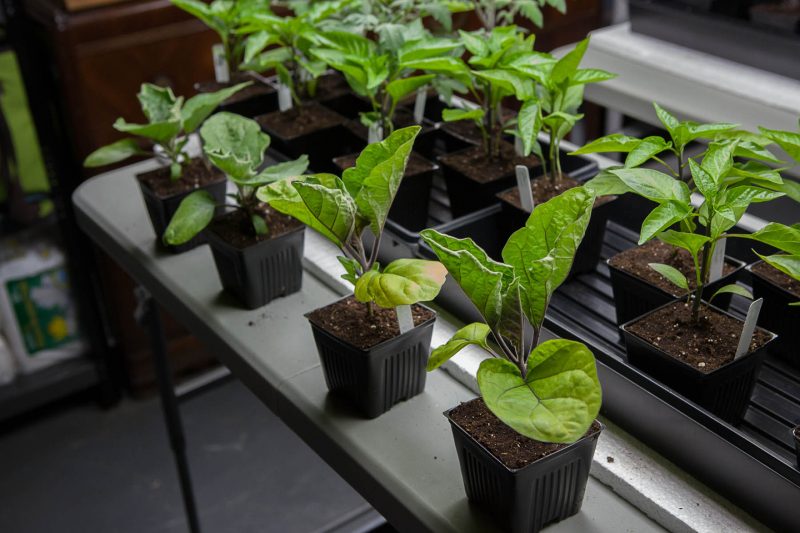
For those varieties of eggplant that will be grown in open ground, it is necessary to conduct the hardening of seeds to ensure their cold resistance. For closed ground, and especially if the blue ones grow in a polycarbonate greenhouse, you can skip the hardening stage of the seeds - the temperature regime will be favorable for this heat-loving crop. But to germinate the seeds is very desirable. In this case, the seedlings will appear much faster - in 5-6 days. But first, the seeds should be awakened by soaking in a growth stimulator: epine, zircon, humate or fly ash. Soaking is carried out in accordance with the instructions on the packaging of the drug. An ash extract is prepared by diluting Art. a spoonful of ash. Soaking time - 12 hours.
To hatch, the seeds are placed on a plate or saucer on moist cotton pads and create greenhouse conditions for them by putting a plastic bag on the dishes. Ventilate them at least once a day.
The soil for sowing must be loose and consist of the following components:
- 5 parts of turf land;
- 4 parts of humus;
- 1 parts of sand.
For each bucket of soil, you can add 5 g of nitrogen and 10 g of phosphorus and potassium fertilizers.
Eggplants are grown in peat pots, sowing in each 1 hacked seed to a depth of about 1.5 cm in moist soil.
Eggplants react extremely negatively even to small damage to the root system and recover for a long time, so it is better to grow them without picking.
Before shoots appear, crops should be at a temperature of about 25 degrees. Then the temperature is slightly reduced and kept within 16 degrees during the day and 14 at night.
After 5 days, when the root system of small shoots grows a little, and the stalk grows stronger, the conditions for comfortable growth will be as follows:
- the temperature at night is 14 degrees, on a sunny day about 25, and on a cloudy day, about 20 degrees;
- watering - once every 2-3 days with warm water;
- 2 top dressings - the first in the phase of 2-3 real leaves, the second after another 2 weeks; use a complete mineral fertilizer with trace elements, for example, Kemira.
If seedlings are planted in a greenhouse, you can not harden it; for open ground, you can not do without this procedure. When to sow seeds for seedlings? From germination to planting should take about 60-70 days. Be guided by the terms in which the soil warms up well enough so that the planted plants can develop in suitable conditions for them.
Planting eggplant in a polycarbonate greenhouse
It is in a polycarbonate greenhouse that you can create comfortable conditions for growing this heat-loving vegetable. Planting it is necessary only when the air and soil are well warmed up. You can speed up the process of heating the soil by covering it with plastic wrap.
How and when to plant

The minimum temperature of the soil for the successful growth of eggplant is 15 degrees, and air - 18 degrees heat. Upon reaching these indicators, seedlings can be relocated to the greenhouse. The planting rate per 1 square. m each grade has its own. It must be observed so that for the development of plants there is enough food area. Eggplant is planted in pre-prepared and plentifully spilled water holes, without deepening the seedlings, since it does not form additional subordinate roots. For the same reason, hilling plants does not make sense either. Hilling is only necessary if the roots of the plants are bared for any reason.
What can I plant?
Eggplant love moist soil, but dry air, they get along with plants that have the same requirements:
- tomatoes - when growing both crops, distribute the plantings together so that tall tomatoes do not obscure the eggplant;
- melon - when planting with eggplants, it is better to let it in the spread, and not tie it to the trellis;
- onions on greens;
- pepper, but only sweet, from bitter varieties the taste of eggplant worsens;
- cucumbers are not very desirable, but possible neighbors, if they are planted on the north side of the greenhouse;
- legumes, but in this case onions, as an additional neighbor, are not suitable, incompatibility with peas and beans is with them;
- flowers - marigolds and calendula, they repel pests well.
When planning planting, do not forget that each plant requires a certain area of nutrition, and competition for light, moisture and nutrients will inevitably lead to loss of crop.
Soil preparation and location
Eggplants love to eat, so the soil for them should be fertile. Prepare a greenhouse in the fall: remove plant debris, disinfect, dig up the soil. For digging, make about a bucket of humus or rotted compost and 80 g of complex fertilizer per 1 sq. Km. m beds. It’s good to add a glass of ash to the same area.
If the soil has an acid reaction, it is not suitable for eggplant. It is necessary to lime it with autumn using dolomite flour. The application rate depends on the pH of the soil, they are given on the packaging with a liming agent. It should be borne in mind that the simultaneous introduction of organics and a deoxidizer can lead to large losses of nitrogen - these operations are best separated.
In the spring they dig only heavy clay soils, the rest just loosen. Eggplant prefers loose and light soils, so sand and peat need to be added to clay and loam.
If representatives of the nightshade family grew in the greenhouse last year, it is better to completely replace the top layer of soil 10 cm thick - it is depleted by the previous culture, pathogens and pests could overwinter in it. It is clear that soil from the garden where peppers, potatoes or tomatoes were grown is not suitable for replacing the soil.
Eggplant is very demanding on lighting, it does not tolerate shading, so the greenhouse should be lit all day.
Eggplant care in the greenhouse
Eggplant is a demanding culture. To get a crop, you need to provide him with light, heat, moisture and nutrition in full.
Temperature mode
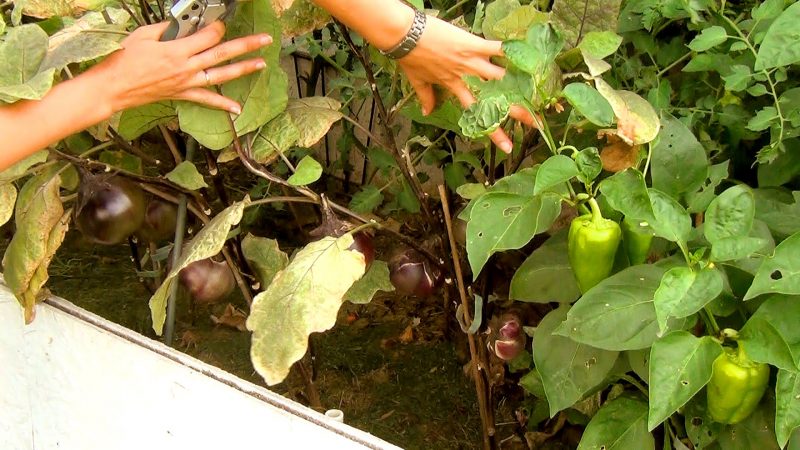
The most comfortable temperature for the development of this vegetable is in the range from 24 to 28 degrees during the day and not lower than 15 degrees at night. At a higher day temperature, pollination does not occur, the ovaries may fall. The temperature can be reduced by ventilating the greenhouse, but the doors and windows are opened only on one side, as the eggplant negatively reacts to a draft. You can lower the temperature a little by watering the paths with cool water, but not the bed itself. At night, the greenhouse is closed.
Watering, fertilizing and fertilizing
The best way to water an eggplant is to drip. If it is not possible to organize it, eggplant is poured under the root with warm water, pouring over a bucket or a little more per 1 sq. m once a week in cloudy weather and every 3-4 days - in sunny. With the onset of flowering, the frequency of watering is increased, and the rate is left unchanged. Watering should be in the morning.

Eggplant loves dry air. Before flowering, an air humidity of 60% is sufficient for it, with the beginning of flowering to ensure full pollination, it is increased to 70-80%. Mulching with organic materials up to 10 cm thick will be of great help in maintaining soil and air humidity at the proper level. It is carried out immediately after transplanting seedlings, leaving a small empty space around the stem.
Mulch will be an additional nutrition for plants, but one is not enough. Eggplants need to be fed regularly with a frequency of once every 10-14 days, using a soluble complex fertilizer with microelements intended for tomatoes at the rate of 1 tbsp. spoon on a bucket of water. After the first fruits are tied, they switch to nitrogen - phosphorus top dressing according to Art. spoon of ammonium nitrate and superphosphate in a bucket of water.
Loosening and tying
If the soil is not covered with mulch, it must be loosened regularly. Do this carefully, given that the root system of eggplant is superficial. Loosening the day after watering is especially useful.
Eggplant is tied up when the plants reach a height of 30 cm. The peg must be stable and strong so that the bush loaded with the crop does not turn out of the ground.
Plant formation
To direct all the power of eggplant to ripen the crop, the bushes form. As a rule, there is complete information on the formation of a variety on a bag with seeds.
But there are general patterns:
- for low-growing varieties, the formation consists in removing all stepsons and leaves before the first fork, but in hot weather they do not do this so that the roots do not overheat;
- weak plants, regardless of growth, form in one stem;
- all the others pinch the top at a height of 30 cm, achieving branching of the bush;
- of the resulting shoots leave as much as is necessary for each particular variety, choosing the strongest; in tall varieties - this is 2 stems, in the rest - from 3 to 5;
- with further branching out of 2 shoots, leave one, the strongest, pinch the second over the ovary;
- each shoot should have 1-2 fruits, this rule does not apply to carpal varieties; after the formation of the fruit, pinch the shoot, leaving 2-3 leaves over the eggplant for nutrition;
- all excess fruits and ovaries are removed, as well as yellowed leaves;
- about a month before the end of the growing season you need to pinch all the tops and remove all the flowers, leaving 5-7 ovaries.
How to pinch eggplant?
This plant has a fragile stem, so you need to handle it carefully. Stepsons break off their hands, and overgrown - cut off with secateurs. When removing stepchildren, you need to individually approach each plant, taking into account what load it can withstand. Start stepsoning in the third week after landing, spend it with a frequency of once every 2 weeks.
Diseases, pests and control methods
Eggplant diseases are the same as all plants of the nightshade family: late blight, white and gray rot, fusarium, anthracnose and cercosporosis cause fungal microorganisms, and the columnar and mosaic are caused by viruses.
When there are signs of fungal diseases - brown spots, rot on the fruits resort to copper-containing fungicides: copper sulfate, HOM. If this is not sufficiently used, contact or systemic fungicides - Quadris, Antracol. Before treatment, all affected parts of the plant are removed.
There are no effective remedies for viral diseases. The affected plant is removed, all equipment is disinfected.
Among the pests in the first place is the Colorado potato beetle. This insect loves eggplant even more than potatoes. On a small area, it is better to carry out manual collection of the pest, not forgetting to destroy the egg laying.
Annoying eggplant and spider mites. Against it, it is better to use acaricides - Fitoverm, Bitoxibacillin. Have to spend at least 4 treatments with a multiplicity of 5 days.
Aktara and Fitoverm help well from whiteflies. To kill adult insects, glue traps are hung.
Growing eggplant is a difficult but exciting activity. The reward will be an excellent harvest of tasty and healthy fruits.












